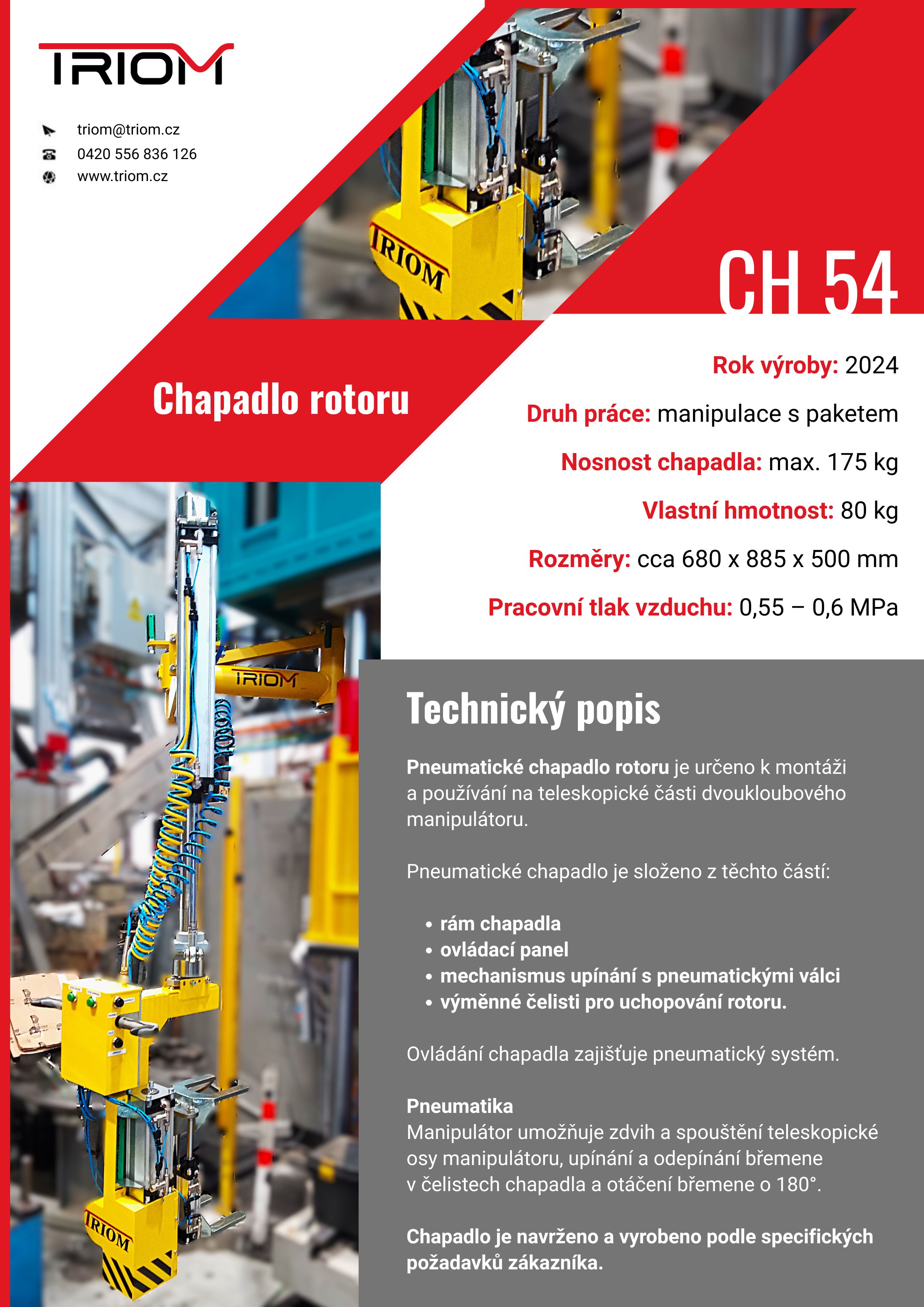10.Nov 2025
Pneumatic Grippers for Manipulators
Principle, Function, and Design of Pneumatic Grippers
Pneumatic grippers use the principle of converting compressed air pressure into linear mechanical motion.
Basic Components of a Pneumatic Gripper
- Support frame (mounted, welded)
- Pneumatic circuit
- Pneumatic cylinder
- Control panel
- Jaws
- Linear guidance
- Synchronized transmission
Overview of Pneumatic Gripper Types for Manipulators
Since TRIOM manipulators often handle large and heavy loads, it is essential to select robust gripper types with sufficient force. Grippers can be divided into angular and parallel types, with both categories having their place in handling equipment.
1. Parallel Grippers (linear jaw movement)
Parallel heads are the most commonly used for handling systems. They offer long service life and allow gripping using either the inner or outer jaw surfaces. The design precision of parallel grippers ensures high comfort when positioning parts. The jaws remain perfectly parallel throughout manipulation, maintaining consistent clamping distribution.
2. Angular Grippers (jaw movement along a circular path)
Angular grippers convert the linear movement of the piston into a swinging (rotational) jaw movement. Compared to parallel grippers, they are usually simpler and therefore more affordable. They are used for gripping materials of various shapes and wherever precise jaw positioning is required.
Angular grippers are divided according to opening angle:
Small opening angle
They use a dual-piston mechanism that achieves high gripping forces while maintaining compact dimensions. The self-locking design of some types ensures material retention even if the pressure drops, ideal for working with heavy workpieces.
Large opening angle
They use cam mechanisms or a toothed piston rod and pinion to convert linear force into rotational torque.
TRIOM Rotor Pneumatic Gripper

TRIOM specializes primarily in custom-made solutions. An example is the pneumatic rotor gripper / type CH 54, designed for installation on the telescopic part of a manipulator. The technical parameters clearly indicate its suitability for heavy-duty applications:
• Load capacity: max. 175 kg.
• Own weight: 80 kg.
• Working air pressure: 0.55–0.6 MPa (5.5–6 bar).
• The gripper allows clamping, releasing, and rotating the load by 180°.
• Manipulation includes clamping control (green indicator) and the operator controls the jaws using RELEASE and CLAMP buttons.
This type of gripper is a typical example of a robust pneumatic solution for high-load handling equipment.
Design and Sizing of Pneumatic Grippers for Handling Systems
To ensure reliable and safe manipulation of heavy loads using single-joint and dual-joint manipulators or rail-mounted manipulators, correct gripper design is essential. The gripping force must be sufficient to prevent any movement of the material during the entire handling process.
When designing friction-based gripping systems, it is recommended to choose a force at least greater than the weight of the handled object. This compensates for accelerations and impacts during manipulation.
For manipulators with telescopic arms, the relationship between the load weight and the offset distance is important. The offset distance is measured from the telescope axis to the gripping point. As the arm extends, the permissible load naturally decreases.
It is also necessary to consider external loads and moments acting on the jaws (Mx, My, Mz). For long arms and heavy loads, it must be verified that external forces and moments do not exceed the manufacturer’s permitted static limits.
Operational and Maintenance Requirements of Manipulator Grippers
Pneumatic equipment is highly reliable because it contains relatively few parts that can fail. Components are often metal, increasing durability. However, for long service life, prescribed operating requirements must be met. Proper maintenance can significantly extend the service life of grippers compared to neglected systems.
Pressure and air quality
For optimal performance, a pressure of 6–8 bar is usually recommended. For the TRIOM CH 54 rotor gripper, the working pressure is 5.5–6 bar (0.55–0.6 MPa). The air must be clean and dry (recommended Class 3.4.3 according to ISO 8573-1). Poor air quality is often the main cause of premature gripper failure.
Contamination prevention
It is necessary to prevent the ingress of aggressive media such as dust or molten plastic. For dusty environments, versions with protective bellows or sealed designs are available (e.g., silicone rubber for food processing).
Lubrication and maintenance
Some systems require regular checks and refilling of lubricant in the compressor and pneumatic components, as well as regular draining of the compressor’s pressure vessel. Seal wear is indicated early by pressure loss or reduced clamping force, with replacement intervals usually between 1–3 years depending on cycle frequency.
Dynamic loads and jaw design
Sudden movements and dynamic loads must be avoided as they can damage the gripper or release the material. To maximize service life, set the lowest suitable closing/opening speed.
Pneumatic grippers are ideal for frequent and heavy-duty work in a fixed location where high force and consistent performance are required — making them an excellent choice for TRIOM manipulators.
Use on Manipulators
Pneumatic gripping tools are an integral part of handling equipment. On single-joint, dual-joint, and rail-mounted manipulators, they are used for:
• Handling heavy loads.
• Machine tending systems, e.g., removing molded parts in plastic injection (EOAT systems).
• Clamping molded parts in molding shops or holding components in paint shops.
• Transporting and packaging food products or gripping and assembling small electronic components (within assisted manual handling).
TRIOM manipulators can be equipped with mechanical pneumatic grippers as well as grippers with vacuum suction cups (we’ll cover those another time). Single-joint, dual-joint, and rail-mounted manipulators are robust, proven, and durable constructions that can be complemented with various grippers, such as the rotor gripper presented here.

